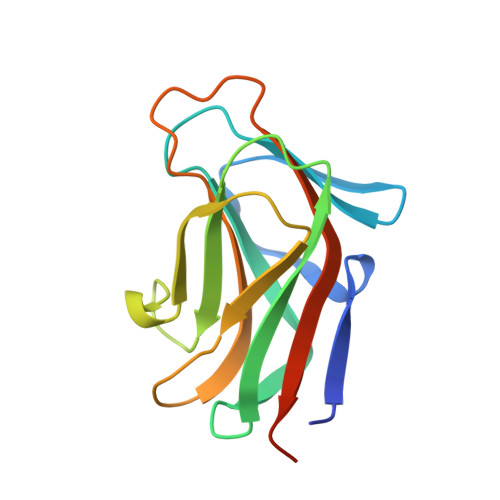Molecular insight into a new low-affinity xylan binding module from the xylanolytic gut symbiont Roseburia intestinalis.
Leth, M.L., Ejby, M., Madland, E., Kitaoku, Y., Slotboom, D.J., Guskov, A., Aachmann, F.L., Abou Hachem, M.(2020) FEBS J 287: 2105-2117
- PubMed: 31693302
- DOI: https://doi.org/10.1111/febs.15117
- Primary Citation of Related Structures:
6SGF - PubMed Abstract:
Efficient capture of glycans, the prime metabolic resources in the human gut, confers a key competitive advantage for gut microbiota members equipped with extracellular glycoside hydrolases (GHs) to target these substrates. The association of glycans to the bacterial cell surface is typically mediated by carbohydrate binding modules (CBMs). Here, we report the structure of RiCBM86 appended to a GH family 10 xylanase from Roseburia intestinalis. This CBM represents a new family of xylan binding CBMs present in xylanases from abundant and prevalent healthy human gut Clostridiales. RiCBM86 adopts a canonical β-sandwich fold, but shows structural divergence from known CBMs. The structure of RiCBM86 has been determined with a bound xylohexaose, which revealed an open and shallow binding site. RiCBM86 recognizes only a single xylosyl ring with direct hydrogen bonds. This mode of recognition is unprecedented amongst previously reported xylan binding type-B CBMs that display more extensive hydrogen-bonding patterns to their ligands or employ Ca 2+ to mediate ligand-binding. The architecture of RiCBM86 is consistent with an atypically low binding affinity (K D about 0.5 mm for xylohexaose) compared to most xylan binding CBMs. Analyses using NMR spectroscopy corroborated the observations from the complex structure and the preference of RiCBM86 to arabinoxylan over glucuronoxylan, consistent with the largely negatively charged surface flanking the binding site. Mutational analysis and affinity electrophoresis established the importance of key binding residues, which are conserved in the family. This study provides novel insight into the structural features that shape low-affinity CBMs that mediate extended bacterial glycan capture in the human gut niche. DATABASES: Structural data are available in the protein data bank database under the accession number 6SGF. Sequence data are available in the GenBank database under the accession number EEV01588.1. The assignment of the Roseburia intestinalis xylan binding module into the CBM86 new family is available in the CAZy database (http://www.cazy.org/CBM86.html).
Organizational Affiliation:
Department of Biotechnology and Biomedicine, Technical University of Denmark, Lyngby, Denmark.




















